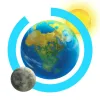
Digital Citizenship Week is October 20–24!
Join teachers worldwide to promote a healthy, positive approach to media and tech.
Take a look inside 5 images
Arloon Solar System
Pros: Kids can zoom, rotate, read, and explore, making meaning on their own from what they find.
Cons: Kids can't click on specific objects to learn more; there's less interactivity here than in other apps from this developer.
Bottom Line: A detailed, thought-provoking tool for taking an interactive journey through the solar system.
Teachers can use Arloon Solar System to emphasize NGSS Cross Cutting Concepts of Patterns, Scale, and Systems Modeling as students examine the Earth’s place in the universe. The app works best when you let kids play first. They'll notice patterns and ask good questions. If they rotate Mars, kids can discover the polar ice caps for themselves and use the facts provided to see that the average temperature is below 63 degrees. This might prompt them to ask why Mars is so cold, and they'll consequently check out its location in comparison to the sun. To have kids explore patterns, ask kids to make observations and look for patterns in the night sky. Have kids sketch the moon over a month and use Arloon Solar System to explain the pattern and predict how the moon might look over the next few nights.
Arloon Solar System lets students explore the sun, Earth, moon, and our neighboring planets in detail. Kids use interactive technology to manipulate parts of our solar system to observe scientific phenomena like phases of the moon, tides, and eclipses. In the Celestial Bodies menu, kids click on an image of a natural satellite, meteoroid, asteroid, artificial satellite, or comet, and up pops interesting information. Users can also drag and drop planets to compare their sizes or zoom in on one planet and read a list of facts. Then they can test their knowledge in the Space Station and earn badges for challenges they complete.
Arloon Solar System capitalizes on kids’ natural fascination with space. It allows students to control their own learning by intuitively moving through the solar system, and it helps students appreciate the universe's scale as they expand and shrink portions of our system. These flexible exploration features let kids understand the size and location of Earth in relationship to other planets and objects in space. As kids ask questions about why the moon looks different in the sky each night or why the tides go in and out, they can use this app to discover the answers for themselves.
Unfortunately, this app doesn't provide the same level of interactivity as other apps by the same developer. It could be improved by allowing kids to zoom through the gas that makes up Jupiter and its 14 satellites and moons while they read about it. Similarly, when kids are curious, they can’t click objects like a solar flare to find out what it is; adding this feature would heighten the experience and further promote student learning. Overall, this is a great tool for virtual, self-directed exploration, and it would be even better with even more of the clickable, zoomable features present in other products.











